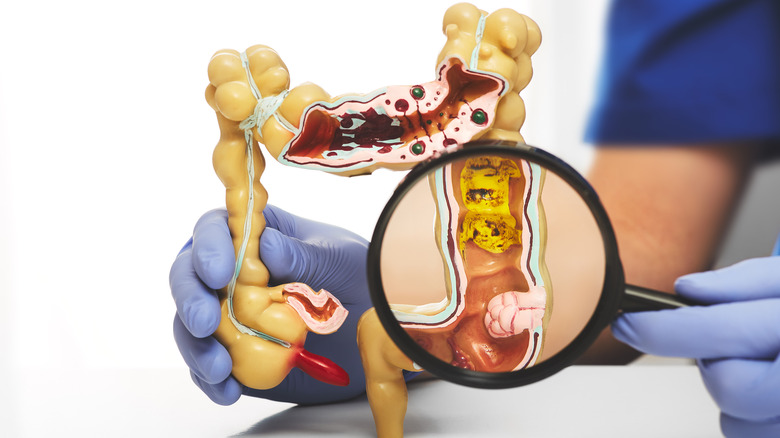Colon Cancer Symptoms & Treatment
Any form of cancer begins when cells in the body begin to grow out of control. Colon cancer occurs when malignant, i.e. cancerous, tumors form inside the colon. It can be located either in the lining of the intestine or in the rectum, which is the last part of the organ. The stage, or extent of spread, of a colon cancer depends on how deep it has grown into the wall of the organ and whether it has spread outside the colon or rectum. Colon cancer in the early stages usually presents zero symptoms, so early diagnosis is a key factor.
In most cases of colon cancer, the disease begins with the development of polyps. Polyps are growths on the inner lining of the colon or rectum. Most polyps are benign, but some types of polyps can turn into cancer over time. The most common form of polyps associated with the possibility of developing colon cancer is adenomatous polyps, as the majority of colon cancers are adenocarcinomas.

Risk factors for colon Cancer
The risk of colon cancer increases after the age of 50. It is also more likely to occur when there are:
- Colon polyps, especially adenomatous polyps which are a pre-cancerous condition. If a polyp larger than 1 cm or more than 3 together is found, or if a polyp changes after its removal, which is also a precancerous condition, then the risk of having colon cancer increases.
- Family history of colon cancer
- Familial adenomatous polyposis
- Inflammatory bowel diseases (IBD) such as ulcerative colitis or Crohn’s disease
- Obesity
- Diabetes
At the same time, adopting a high-fat, low-fiber diet with an increased consumption of red meat, smoking, and drinking alcohol have been found to increase the risk of colon cancer.
Colon cancer symptoms
Colon cancer in its early stages may not cause any symptoms until it develops and spreads to other parts of the body. If you develop symptoms of colon cancer, they include diarrhea or constipation, feeling like your bowels are incomplete, blood in the stool or in the toilet, frequent abdominal pain or cramps, feeling full or bloated, weight loss for no apparent reason, tiredness, nausea or vomiting. Over time, blood loss can build up and can lead to a low red blood cell count, known as anemia. Sometimes the first sign of colon cancer is a blood test that shows a low red blood cell count.
Many of these symptoms can be caused by conditions other than colon cancer, such as the development of an infection, hemorrhoids, or irritable bowel syndrome. That is why it is extremely important to visit a specialist and carry out diagnostic tests, in order to ascertain the cause of the symptoms.
Colon cancer diagnosis
As colon cancer in an early stage may not show any symptoms, it is imperative to carry out regular preventive examinations and consequently early diagnosis. It is important for all people over the age of 50 to be screened. The most common diagnostic test for colon cancer is a colonoscopy, during which a biopsy is also taken to diagnose the disease. During the biopsy, the doctor removes a small piece of tissue with a special instrument which is then subjected to a histological examination. Other diagnostic tests that can be applied are the CT scan of the upper and lower abdomen and chest, but also MRI if the condition is located in the rectum or anus.
Colon cancer treatment
Surgery is often the main treatment for early-stage colon cancers. The type of surgery used depends on the stage of the cancer, where it is located in the colon, and the goal of the surgery. The most common surgical procedure to treat colon cancer is a colectomy, which is performed by removing part or all of the colon. At the same time, the patient undergoes chemotherapy or radiation to eliminate any remaining cancer cells.
If only part of the colon is removed, it is called a partial or segmental colectomy. The surgeon removes the part of the colon where the cancer cells are located. Usually, about a quarter to a third of the colon is removed, depending on the size and location of the cancer. The remaining sections of the colon are then reattached. At the same time, part of the neighboring lymph nodes is also removed. Advanced stage cancers may require removal of a larger part of the organ, combined with a colostomy, in which stool is passed through a hole in the abdomen and collected in a plastic bag. Rarely, it may be necessary to remove the entire colon with a total colectomy.
The most modern, minimally invasive surgical technique for treating colon cancer is laparoscopic colectomy. This procedure is performed through several smaller incisions and special tools, such as a laparoscope. A laparoscope is a long, thin tube with a small camera and light on the end that is inserted through one of the incisions and allows the surgeon to see inside the abdomen. The camera image is transferred to a high-definition screen so that the surgeon can monitor his manipulations. Special surgical instruments are inserted through the remaining incisions to successfully remove part of the colon and lymph nodes.

